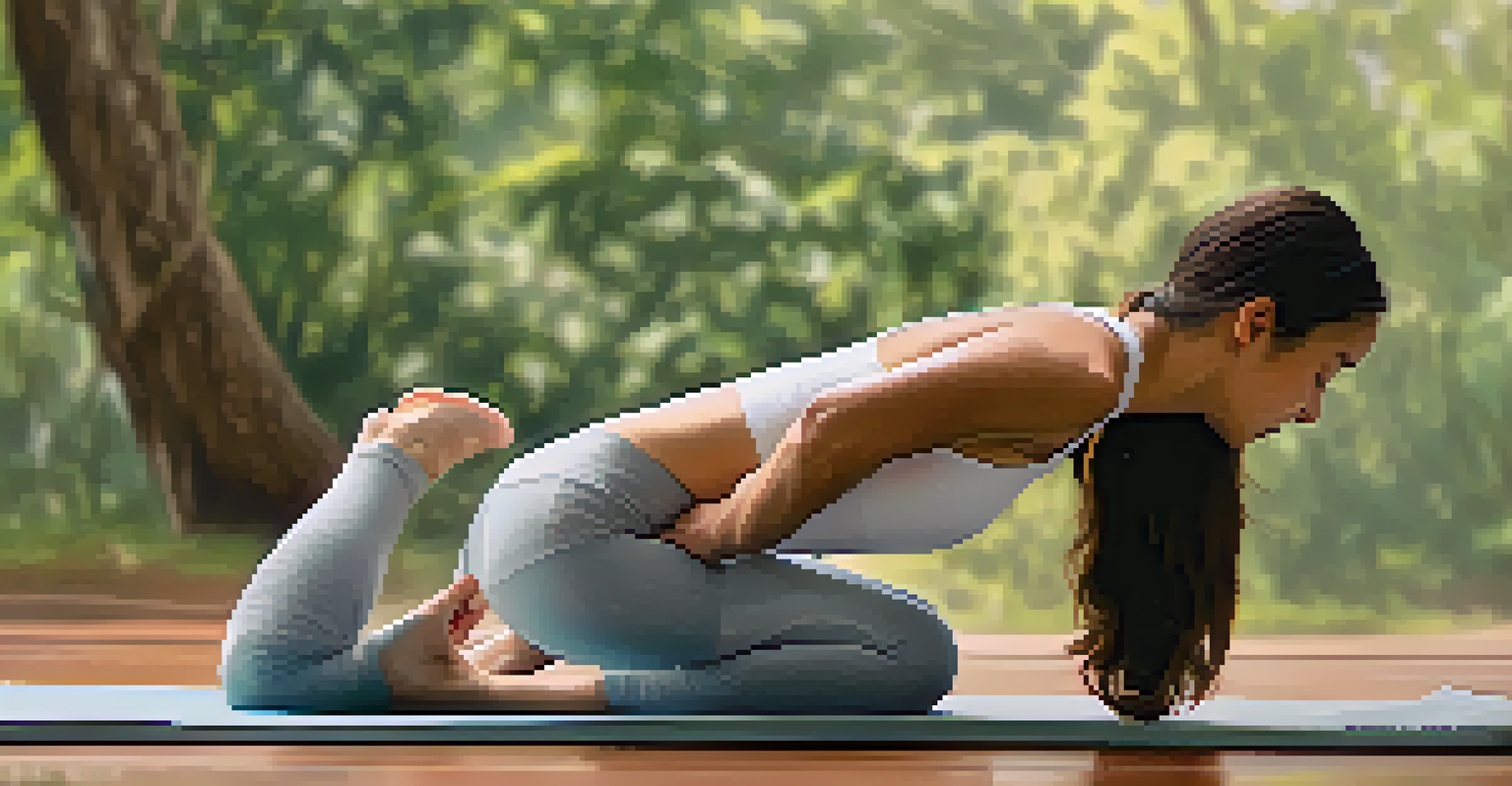Core Strengthening Yoga Routines for All Skill Levels

Understanding Core Strength in Yoga Practices
Core strength is essential for overall stability and balance, making it a cornerstone of effective yoga practice. When we talk about the core, we refer to more than just the abdominal muscles; it includes the back, hips, and pelvic floor. A strong core supports proper alignment and helps prevent injuries, allowing practitioners to explore more advanced poses safely.
The body achieves what the mind believes.
Focusing on core strength not only enhances physical performance but also contributes to better posture and breathing. Think of the core as the trunk of a tree: it provides the foundational support that allows the branches—your limbs—to extend freely. This relationship is crucial for both beginners and seasoned yogis who want to deepen their practice.
Incorporating core-strengthening routines into your yoga sessions can lead to a more enjoyable and effective experience. Whether you're just starting or looking to improve your skills, these routines can be tailored to fit your individual needs. So, let’s explore some effective yoga poses that will help you build that strong core.
Essential Yoga Poses for Core Strengthening
There are several yoga poses specifically designed to engage and strengthen the core. Some of the most effective poses include Plank, Boat Pose, and Warrior III. Each of these poses challenges your body in different ways, targeting various core muscle groups for a comprehensive workout.

For instance, the Plank Pose requires you to maintain a straight line from head to heels, engaging your abdominal muscles significantly. Meanwhile, Boat Pose creates a strong contraction in the core as you balance on your sit bones, lifting your legs and arms. These poses not only build strength but also improve your overall balance and stability.
Core Strength Supports Stability
Building core strength is essential for stability and balance in yoga, allowing for safe exploration of advanced poses.
Integrating these poses into your routine can vary based on skill level. Beginners might hold each pose for a shorter duration, while advanced practitioners can increase the time or even add variations to deepen the challenge. No matter your level, consistency is key to seeing results.
Adapting Yoga Routines for Beginners
If you're new to yoga, starting with simpler variations of core-strengthening poses can help you build confidence and strength. For example, performing a modified Plank on your knees can make it more approachable while still engaging your core muscles. The goal is to ensure you're feeling the work in your core without straining.
Yoga is not about touching your toes, it is what you learn on the way down.
Another beginner-friendly option is to include supported poses, like using a wall or a chair for balance. This allows you to focus on your form without the fear of tipping over. Remember, yoga is about progress, not perfection, so take your time to understand each pose.
As you grow more comfortable, gradually introducing more challenging variations will enhance your core strength even further. The key is to listen to your body and adjust your practice to match your skill level, ensuring a safe and fulfilling experience.
Progressing to Intermediate Core Workouts
Once you've built a foundation, you can begin to explore intermediate routines that challenge your core stability and strength. Incorporating poses like Side Plank or Half Moon can add variety and intensity to your practice. These poses require not just strength but also balance, making them excellent for developing a well-rounded core.
At this stage, you can also experiment with flow sequences that connect core-strengthening poses together. For example, transitioning from Plank to Chaturanga Dandasana (Four-Limbed Staff Pose) not only builds strength but also improves coordination and fluidity in your movement. This helps you develop a deeper connection with your body.
Beginner-Friendly Core Practices
New practitioners can start with modified poses and supported variations to gradually build core strength and confidence.
As you navigate through these intermediate routines, ensure that you're maintaining proper alignment and engaging your core at all times. This will not only enhance your practice but also help you avoid common injuries. Embrace the challenge and enjoy the journey of growth in your yoga practice.
Incorporating Breath Work into Core Routines
Breath work, or pranayama, plays a crucial role in enhancing core strength during yoga. Learning to coordinate your breath with movement can help engage your core more effectively. For instance, inhaling when lengthening your spine and exhaling while contracting your core can create a powerful connection between breath and muscle engagement.
As you practice, try to visualize your breath flowing into your core, filling it with energy and strength. This mental imagery not only helps with focus but also reinforces the physical engagement of your core muscles. Practicing breath control can significantly elevate your yoga experience.
Additionally, incorporating breath work can ease tension and promote relaxation, which is essential for recovery after challenging core workouts. Remember that every inhale and exhale is an opportunity to connect deeper with your body, enhancing both strength and mindfulness in your practice.
Creating a Balanced Core Yoga Routine
A well-rounded core yoga routine should include a mix of strength, flexibility, and balance. This balance ensures that you’re not only building strength but also improving flexibility in your core muscles, which can enhance overall performance. For instance, incorporating poses like Cobra or Upward-Facing Dog after core work can stretch and open the abdominal area.
You might also consider adding restorative poses like Child's Pose or Supine Twist at the end of your routine. These help to relax your core after a workout, promoting recovery and preventing stiffness. A balanced approach not only supports your core strength but also enhances your overall well-being.
Breath Work Enhances Core Engagement
Incorporating breath work into yoga routines helps connect core muscles with movement, promoting strength and relaxation.
Lastly, remember that consistency is vital. Aim to practice these routines regularly, allowing your body to adapt and grow stronger over time. Adjust your routine as needed, and always listen to your body’s cues to find the perfect balance for you.
Tips for Staying Motivated in Your Yoga Journey
Staying motivated can be challenging, especially when building core strength requires persistence. One effective way to maintain motivation is to set achievable goals. For example, aim to hold a Plank pose for a few seconds longer each week, celebrating small victories along the way. This can keep your practice fresh and exciting.
Another tip is to join a yoga community, whether in-person or online. Sharing your journey with others who share similar goals can provide encouragement and accountability. Plus, you can exchange ideas and routines that might inspire you to try something new.

Finally, remember to be kind to yourself. Progress in yoga isn't always linear, and some days will be more challenging than others. Embrace the journey and enjoy each moment on your mat, knowing that every practice is a step toward a stronger core and a healthier you.